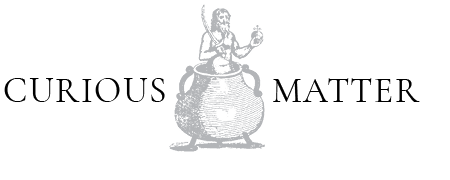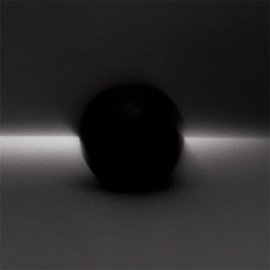Dividing Light, Measuring Darkness
October 1 – November 6, 2011
Abraham McNally, Untitled, 2009. Firewood, mirrors, 3 x 4 x 2 feet.
Kym O’Donnell, After Stavely Bulford, 2011. Cynaotype, 5 x 7 inches.
Ken Collins, Sacred Geometry, #16, 1999. Photograph, 9 x 9 inches.
Heidi Lau, The Cave, 2011. Glazed ceramic, 10 x 12 x 13 inches.
And of a sudden he is off again on his wanderings, passing from light to shadow, from shadow to light, unheedingly.
– Samuel Beckett, Malone Dies
PHOTONS FIRST APPEARED ten seconds after the Big Bang, signaling the first light. In the Judeo-Christian tradition God separated light from darkness on the first day of Creation. In Greek Mythology Nyx (night) with her consort Erebos (darkness) gave birth to Hemera (day). In all of these systems, from ancient myth to modern science, light comes out of darkness. Light and darkness are separate entities, but dependent upon one another. With Dividing Light Measuring Darkness, Curious Matter explores our diverse human responses to the benign physical properties of light and darkness.
The Ancient Greeks assigned personalities to darkness and light, which we still use today. Nyx was gloomy, threatening and gave birth by herself to horrible monsters as well as such negative attributes as Blame, Strife, Doom and Death. Hemera, on the other hand, dissipates the dark veil that Nyx draws over the earth. Hemera reveals the shining air of Aither, the bright heavens where the gods live. Darkness hides dangers while light reveals and comforts. Thus we conceive of darkness as negative and light as positive.
Ken Collins’ Sacred Geometry #16 has the primordial aspect of light separating from darkness. Whether the product of the Big Bang or Alchemy, it emits an air of the mysterious that is the property of both. Hannah Kirkpatrick mines similar territory with Eye Cavern. Her dark glass sphere could be the universe before the Big Bang, or a black hole with light trapped inside.
The physical properties of light; its ability to be reflected and refracted become the subject of Brian Edgerton’s video, (False Color) Foil. The visible spectrum pulses across the faceted metallic surface, a rhythmic play.
The lightless depths of the cave inspire horrific imaginings of terrors lurking within. Heidi Lau gives us a glimpse of what may lie beyond the shadows with her sculpture The Cave. Sharp, fang-like projections suggest a mouth to the underworld that will swallow the unwary. Skull-like shapes among the stalactites and stalagmites warn what fate has in store to all who enter.
Our primal fears of the dark were calmed once humans learned to use fire. Its friendly radiance soothed anxious thoughts. Yet, fire is a fickle friend and refuses to be tamed; it can also burn and easily destroy. Abraham McNally investigates the ambiguity of its power with his sculpture of rough-hewn firewood and mirror. The latent energy of fire and the reflective surface of the mirror suggest both active and passive elements of light.
Light and darkness have their psychological aspects. Jaclyn Conley and Erin Rachel Hudak see the dark side of human behavior through our emotional projections on animals. For Hudak, the wolf takes on the sinister personality of the cunning hunter in Wait! While Conley explores our primal suspicion of snakes by placing one within the homey glow of a china pantry. The allusion to food and temptations goes all the way back to creation.
Light can also communicate spectral impressions as Kym O’Donnell reveals. After Stavley Bulford depicts a woman with a strange patch of light above her head. Is it the light of spirit or the light of idea? Either way it pierces Nyx’s veil as did Hemera to open our mind to possibility.
The fearsome dark or the joyful light, each is an intertwined yet divergent path. Science and myth tell us light came out of darkness and one cannot be separate from the other. Darkness surrounds and engulfs, while light must travel in a straight line. Darkness hides dangers, light exposes them. We need light to see. We need darkness to dream. The artists of Dividing Light Measuring Darkness evidence both.
THE ARTISTS
Arthur Bruso
Joseph Cavalieri
Ken Collins
Jaclyn Conley
Brian Edgerton
Peter Emerick
Jennifer Ewald
Daniel John Gadd
Tom Hollenback
Erin Rachel Hudak
Patti Jordan
Hannah Kirkpatrick
Tom Koken
Heidi Lau
Ross Bennett Lewis
Abraham McNally
Raymond E. Mingst
Alexandra Momin
David Moreira
Kym O’Donnell
Joey Parlett
Robert Schatz
Hyun-Joon Yoon




